DAYTONA CONTINENTAL 24-HOUR
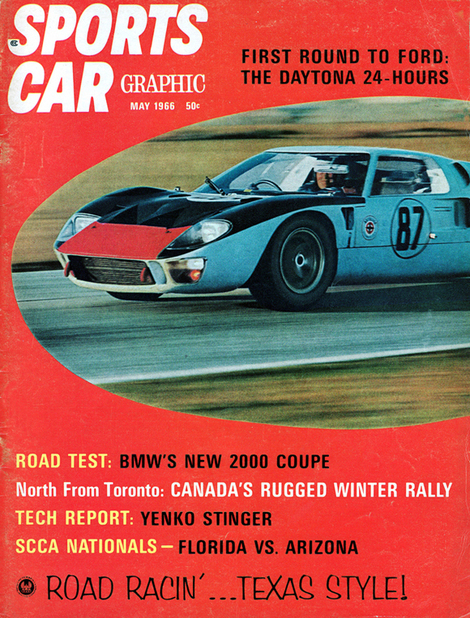
great vid of GT 40 at Daytona
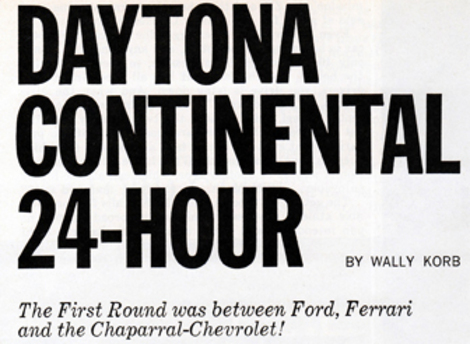
THE SUCCESS STORY OF THE DAYTONA INTERNATIONAL SPEEDWAY'S OPERATION IN GENERAL, and their 'Continental' in particular, is at least impressive enough to make the old Horatio Alger rags-to-riches stories turn green with pure envy.
Remember back to 1962? That first Continental was a three-hour affair with a rather mixed bag of machinery - sports, GT and semi-stocker. And although Dan Gurney blew the engine of his Lotus 19 on the last lap of the race, he was able to win (see May 1962 SCG) by cranking over the finish line on the starter motor.
Two years later the Continental was enlarged to 2000 kilometers (about 13 hours of running on the 3.81-mile course), the field of cars was much more impressive, and the race was won by Pedro Rodriguez/Phil Hill in a Ferrari.
Last year the race was largely unchanged except the field was still more competitive (see May 1965 SCG), largely because the Shelby Cobra/Ford GT threat was so strong. In fact, they swept the Ferrari field embarrassingly clear of the finish line as they took the first six places, with the exception of a fifth-place Porsche 904.
Well, then, where do you go from there? Why, to a 24-hour race, of course, with a still bigger, more competitive field and all the hoopla of 'the biggest and the best.' Not too bad for five years of growth, hey? Next year, perhaps there will be a longer infield portion of track, resulting in a smaller percentage of the course run on the high bank but a greater overall length, enabling a still larger starting field.
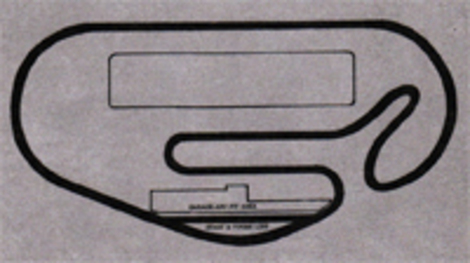
Actually the enlargement of this year's race to 24 hours was probably of less importance than the extremely competitive field of cars which was entered, and the fact that both Ford and Chaparral teams looked on it as a pre-Le Mans test. Taking a quick look at the overall entry picture, 60 cars qualified to start the race. Of that total, 30 of the cars were capable of lapping the course at 100 mph or better, and were then only about 15 seconds apart in their lap times. Fifteen of the total entries were Ford-powered, while Ferrari had twelve cars, Porsche had eight and Chevrolet had four.
Of the Ford-powered cars, five were the new Ford Mk. II (427-inch) variety driven by Miles/Ruby, Hansgen/Donahue, Bucknum/Ginther, McLaren/Amon and Gurney/Grant and qualified first, third, sixth, seventh, and eleventh in the order listed. Ferrari was represented by two P2's driven by Rodriguez/Andretti (NART entry) and Bianchi/Langlois (Ecurie Francorchamps entry) and qualified fourth and fifth, and no less than eight 275 LM's, of which the fastest three were driven by Follmer/Wester (qualified eighth), Wilson/Hulme (ninth) and Piper/Attwood (twelfth).
Porsche had the strongest entry ever brought to the Continental, with a brand new six-cylinder 'Carrera 6' coupe driven by Herrmann/Linge and five 904's, two of which were factory-sponsored and driven by Mitter/Buzzetta and Klass/Schuetz.
Two of the Chevy-powered cars were outstanding, notably the new Chaparral 2-D (see last month's SCG and an earlier post of mine), a coupe of much cleaner lines than the older cars, driven by Phil Hill/Bonnier and qualified second, only 0.2 seconds slower than Miles/Ruby leading time of 1:57.8. Fastest qualifier of the GT vehicles was the Penske-entered Corvette 427, driven by Guldstrand/Moore/Wintersteen and qualified at 2:10.6.
It was tremendously thrilling sight to see this fine field of cars parade around the banked track, but there were misgivings in some minds about cutting loose the pace car on the far side of the track, thereby giving the field only a scant half lap of sorting-out time before turning onto the infield. (Last year's race allowed a complete lap for this sorting-out to take place.) Fortunately all drivers put on a fine display of skill and intelligence, and the first turn was negotiated without any unpleasant incidents.
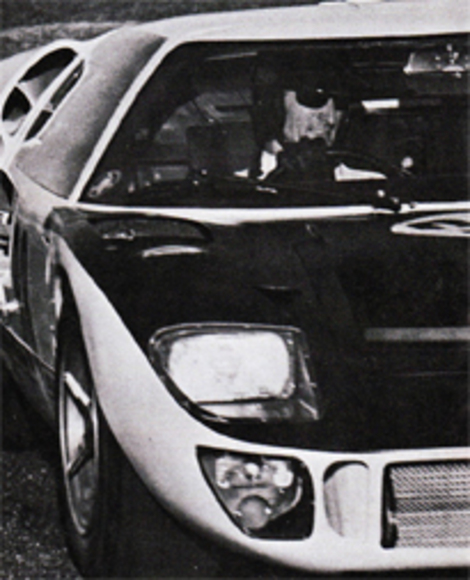 Sent out to play "rabbit" for the Ford team, Ken Miles, above, was able to hold an infallible pace once the Chaparrel, lower right, was out of contention with unexpected ills.
Sent out to play "rabbit" for the Ford team, Ken Miles, above, was able to hold an infallible pace once the Chaparrel, lower right, was out of contention with unexpected ills.
Bonnier jumped into first-lap lead, followed closely by Ken Miles. Miles tired of waiting around on the second lap and promptly blew by the Chaarral on the back straight, where the Mk. II Fords were reportedly capable of 183 mph and the Chaparral some 12 mph slower. For the next 24 hours, the "Hawk" and his co-driver, Lloyd Ruby, would relinquish this lead only 15 more times in 678 go-arounds. In two laps, the pace was established and it was quick - only five seconds off best qualifying time. Bonnier shocked everyone - including Hall's crew - by pulling in on the seventh lap and complaining of strange noises directly aft of his derriere. This was finally traced to fuel-slosh in the reserve tank that is actually built into the seat. Jo had never driven the car with the reserve in service, and he figured it best to find out early what malady was setting in. But it cost precious minutes and removed the immediate Chaparral threat from the leaders.
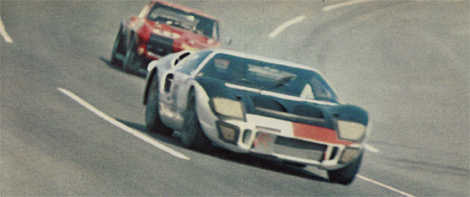 Winner in the GT category, top right, was the Penske-entered 427 Sting Ray, despite necessity of replacing radiator and repairing headlights as a result of two shunts.
Winner in the GT category, top right, was the Penske-entered 427 Sting Ray, despite necessity of replacing radiator and repairing headlights as a result of two shunts.
 the Carrera 6's debut was completely successful as, even with a slipping clutch it stayed well up among the leaders throughout the entire 24-hour event.
the Carrera 6's debut was completely successful as, even with a slipping clutch it stayed well up among the leaders throughout the entire 24-hour event.
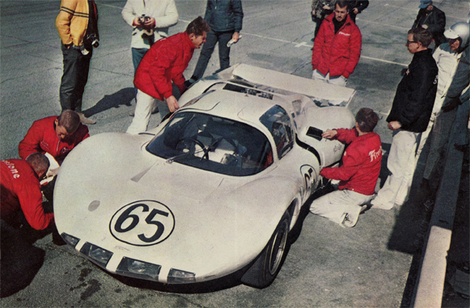 the Chaparral
the Chaparral
The Miles/Ruby car, fielded by Shelby, and the Hansgen/Donahue entry of Holman/Moody were obviously Ford's "rabbits," out to set as near a killing pace as they dared. Gurney and Grant in the other Shelby entry laid back a ways, holding a firm and confident pace. The two quickest Ferrari P2's - Rodriguez/Andretti and Bianchi/Langiois - were holding their own, but not bringing pressure on the leaders.
But the real break in the race came at 3:45 pm when the Chaparral pulled into the pits with steering trouble. After extensive investigation, the trouble was traced to a binding pinion gear and it was repaired as rapidly as possible. But the blow of losing almost exactly one hour so early in the race was a most serious one. Certainly, at this stage of the race, 25 laps were not impossible to catch up, but the fact remains that it put a great deal more of a burden of the chasing and catching on the backs of the Ferrari's.
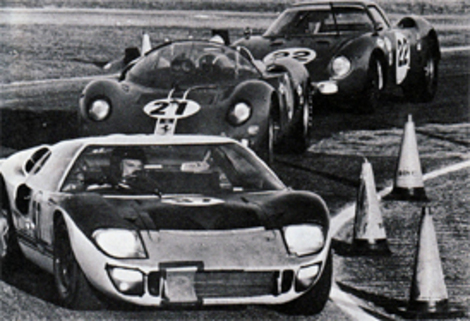 Gurney leads the Ferraris of Rodriguez and Rindt through the tight infield section of the Daytona course. It's not an impressive road circuit. PHOTOS: JERRY TITUS AND JACK BRADY ASSOCIATES.
Gurney leads the Ferraris of Rodriguez and Rindt through the tight infield section of the Daytona course. It's not an impressive road circuit. PHOTOS: JERRY TITUS AND JACK BRADY ASSOCIATES.
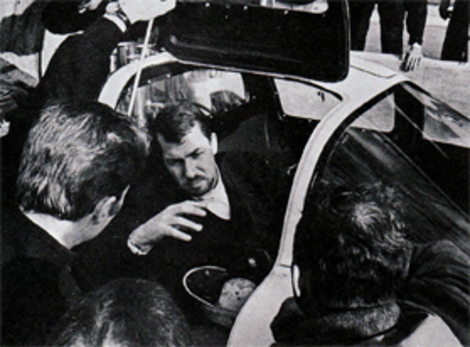 Bonnier tries to describe strange noise to Hall and Hill that caused him to pit on the fifth lap. It turned out to be gas sloshing in the reserve tank.
Bonnier tries to describe strange noise to Hall and Hill that caused him to pit on the fifth lap. It turned out to be gas sloshing in the reserve tank.
Actually, the P2 Ferrari's did indeed put on a good show of pressuring the leaders, running strongly in places just off the pace during the first hours of the race. But the additional effort seemed to work adversely on some of their fellows, as the Wilson/Hulme, Dernier/Ickx and Ireland/Hailwood Ferrari's all went out with transmission failures before four hours had been run.
Meanwhile, Phil Hill had the Chaparral moving at beautiful speed and proceeded to rip off a bundle of laps around 2:01-2:02. But very shortly after five hours another minor but time consuming problem struck in the form of a broken exhaust manifold. After it had been repaired the car was nearly an hour and a half back of the leaders, an almost insurmountable liability to overcome, even in a 24-hour race.
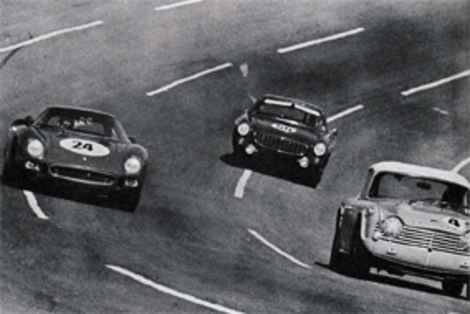 The Maxwell/Martin Volvo and Vega/Byrne TR4 are lapped on the bank by Ireland's 250LM. Volvo finished 21st, the TR4 24th, but Ferrari DNF'd.
The Maxwell/Martin Volvo and Vega/Byrne TR4 are lapped on the bank by Ireland's 250LM. Volvo finished 21st, the TR4 24th, but Ferrari DNF'd.
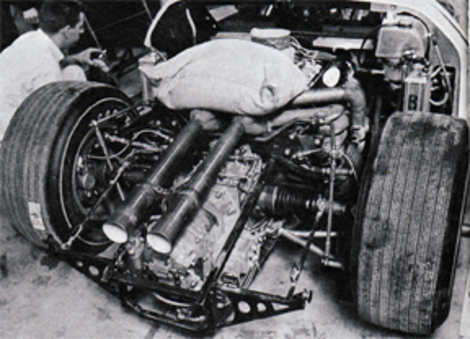 Ford's two-speed automatic transaxle is huge as compared to Chaparral's but has to handle the torque of the 427-in. engine. Overheat put it out.
Ford's two-speed automatic transaxle is huge as compared to Chaparral's but has to handle the torque of the 427-in. engine. Overheat put it out.
At six hours there were at least three Ferrari's which were motoring in contention, the P2's mentioned earlier and the Rindt/Bondurant 275LM. But on Lap 171 the most serious blow to Ferrari hopes was suffered when the Bianchi/Langlois P2, which at this point and throughout the race was driven smoothly and flawlessly by Pedro Rodriguez and Mario Andretti. This is particularly noteworthy in light of the reputation that both have for being hard chargers. If either had really pushed too hard during this stage of the race, the car would surely have been eliminated. Instead, they both drove smart race, and although the car was never placed higher than third, it was most definitely in contention.
One of the Ford Mk. II's was an experimental automatic transmission car, driven by Bucknum/Ginther in a most capable manner, but some several seconds a lap slower than the leading Fords. Ginther had to pit on the second lap. The emergency brake had been left partially on and this boiled the brake fluid. Shortly after midnight the car pitted with almost exactly the same exhaust malay the Chaparral had suffered earlier. Still more of a coincidence both cars retired shortly after 300 laps, although with different ailments this time. The Ford went out with transmission difficulties, while the Chaparral suffered some sort of gradual upper A-arm failure which caused the right rear suspension to give way partially and send Bonnier looping through the infield. The car was officially retired some unlucky thirteen hours after race start.
In spite of the fact that the Chaparral had been out of any serious contention ever since its long stop for steering adjustment, it was popular favorite with many spectators, and its actual retirement saddened them. Hill and Bonnier had given the car a whale of a drive even when it did not appear to have much winning chance, and consistently turned the fastest laps of the middle period of the race. During the twelfth hour Bonnier blasted it around the course to a new competition lap time of 115.8 mph, very close to the best qualifying times of several days before.
Meanwhile, the same Fords that had dominated the lead for so long were continuing to do just that; but in the early morning hours, Rodriguez began bettering his earlier lap times by two to four seconds, in an all-out attempt to pressure the leaders into some serious errors.
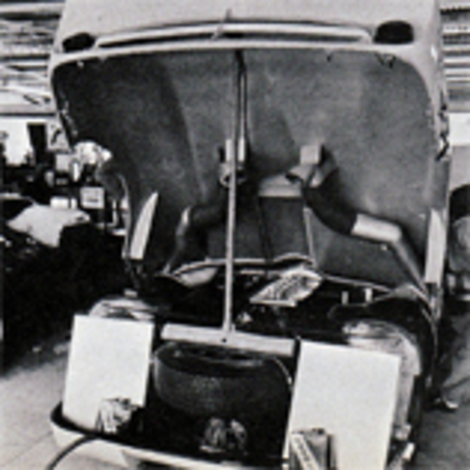 FIA suitcase compartments (two required now) were, as shown on this P2 Ferrari, located in the tail, behind wheels, on most prototypes.
FIA suitcase compartments (two required now) were, as shown on this P2 Ferrari, located in the tail, behind wheels, on most prototypes.
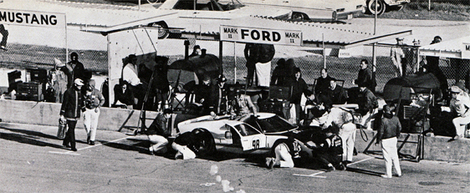 The pit stop that cinched the race. Crew swarms over the Miles/Ruby car to make critical change of front discs, managed it in under 5 minutes.
The pit stop that cinched the race. Crew swarms over the Miles/Ruby car to make critical change of front discs, managed it in under 5 minutes.
The leading Miles/Ruby car was in the admirable position of not even needing to adjust their lap times at all, since they were protected by a buffer zone of two other cars. So it was that the Fords of Hansgen/Donahue and Gurney/Grant took up the Rodiguez challenge with a vengeance. So much so, in fact, that Gurney broke not only the competitive lap record, but the qualification one as well with a sizzling 116.5 mph.
Many more hours remained to be run, and quite a few heartbreaking retirements, coming after even longer hours of racing, were still forthcoming. The Guidstrand/Moore/Wintersteen 427 Corvette was nearly eliminated when it ran afoul of cars and wall late in the race, but it was able to remain in the race (sans most of its nose and requiring eventual radiator replacement) and win the GT class over the Roan/Coleman/Bencker Porsche 911. But little Sebring Sprite which had moved up as high as 22nd place blew spectacularly with only about an hour to run, thereby eliminating the fine drives of Paul Richards and Ray Cuomo.
Long before dawn everyone was taking a long look at the Porsche contingent asa real threat. Herrmann and Linge had been circulating the Carrea 6 at a fantastic pace for an under-two-liter nachine, and the Mitter/Buzzetta 904S was not far behind. Two sedans, a Barracuda and a Rambler Marlin, were trying to go the distance. The Barracuda was turning respectable lap times but the Marlin, looking for all the world like a pregnant skateboard, was a rolling course hazard. It finally lost a wheel and retired, but the wheel bounced off the Gurney/Grant Ford, giving Grant a few bad moments. The Barracuda went on to finish 36th overall.
Two Mustang GT350's were very much in the race, one running as high as 16th overall at one point, then dropping back to finish 26th. This was the Kearney/Reina entry. The other, driven by West and Macon, retired in the predawn hours. Yet the night had not taken the toll many had predicted. At six in the morning there were still 41 cars circulating, most of them fairly healthily.
Of major consequence in the outcome of the race was an anticipated brake disc change on the leading Ford GT's. To improve wear, they were using an impacted copper/iron surface on the discs, and tests had shown this had a probable life of some 13 hours under maximum use. The discs had been modified to slip off the hubs - more or less quick-change-but still required that the calipers be unbolted. Holman-Moody made their change to the Hansgen/Donahue car just after daylight. The stop took approximately 15 minutes. At seven o'clock Miles pitted and the Shelby crew made a swap in under five minutes, taking the pressure completely off the leaders.
As far as the overall race outcome was concerned, little of consequence happened in the last six hours. When it became obvious to Rodriguez that his car would not be able to force three faster cars into anything unpleasant, he dropped his pace back to normal and held on to a sure fourth.
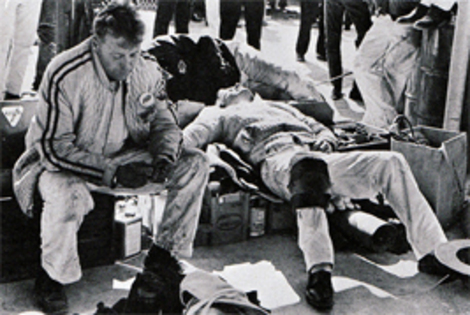 To a crewman, sleep during a 24-hour race is a rare commodity. Using spares for a bed, Shelby mechanic collapses as Phil Remmington times.
To a crewman, sleep during a 24-hour race is a rare commodity. Using spares for a bed, Shelby mechanic collapses as Phil Remmington times.
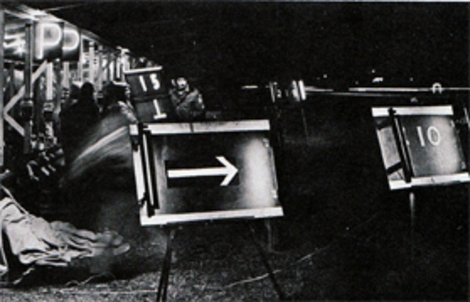 Signaling pits were located behind paddock on short infield straight. Many lighting innovations were applied to the pit boards during night.
Signaling pits were located behind paddock on short infield straight. Many lighting innovations were applied to the pit boards during night.
The liveliest bit of business which transpired during the closing hours was that the Ford Mk. II's of Hansgen/Donahue and Gurney/Grant continued their remarkably close dual for second place. The Gurney/Grant car was part of the Shelby American operation and was running on Goodyear tires, while the Hansgen/Donahue car was Holman-Moody prepared and running on Firestone's. Hmmmm, see the internal politics at work? Or, can you imagine what would happen if the two cars should engage in a big duel for Second which would force both to retire?
Well, gosh, actually the whole tempest subsided when, at the last pit stop, the Hansgen/Donahue car required at least as much time to get back on the course as the Gurney/Grant, and the minute and a half margin which separated them was just too much to shoot at. Oh, well, it would have been interesting.
So the three Ford cars took the first three places, followed by the P2 Ferrari and still another Ford. The really impressive part of the Ford operation was their tremendous durability. For example, three of last year's GT 40's suffered many problems, particularly the Essex Wire entries, both of which lost various cogs in their transmissions. But the new cars, the Mk.II's looked and sounded tremendously strong and actually rivalled the Porsche's in this department, although the Porsche's ran like trains and placed their six-cylinder 'Carrera 6' in sixth place, and their 904's in the first four places in the Sports class.
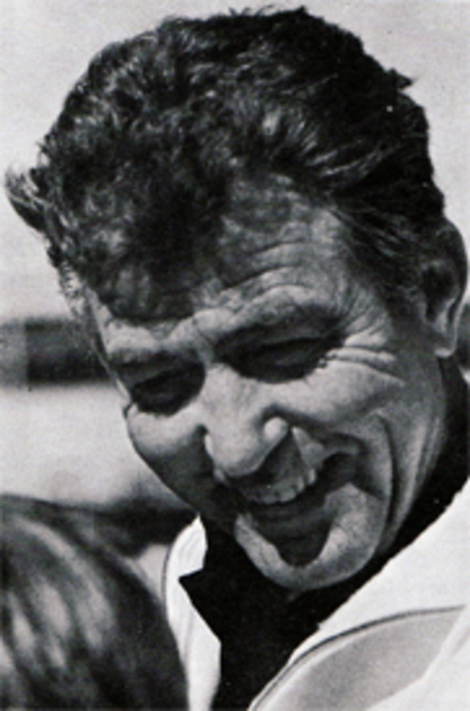 "Make some rash statements about Enzo's posterior? No, I think I'll wait until LeMans...."
"Make some rash statements about Enzo's posterior? No, I think I'll wait until LeMans...."
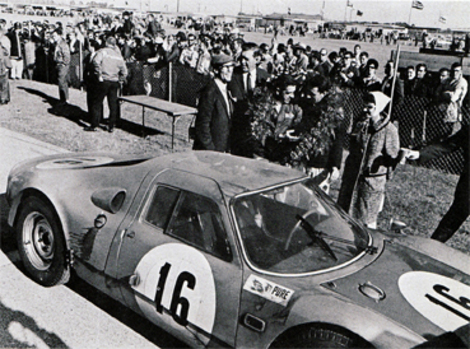 A happy von Hanstein, Bill France, and drivers Buzzetta and Mitter line up for victory kudos after their Sports category win and impressive 7th overall finish in the factory Porsche 904.
A happy von Hanstein, Bill France, and drivers Buzzetta and Mitter line up for victory kudos after their Sports category win and impressive 7th overall finish in the factory Porsche 904.
Daytona being the first in the series of World Manufacture's Championship events, it must be examined to determine the potential of enteries in the forthcoming Sebring and LeMans endurance races. Obviously, the big inches of the Ford Mk.II's will make them the car to beat at LeLans, with its long straights. But the Fords are heavy-reportedly 2300 pounds - and will be at a big disadvantage at Sebring, where the high-adhesion concrete and tight corners make for hellish braking rates, and the lighter Chaparral will have an initial acceleration as well as a stopping advantage. Enzo Ferrari will ddefinately have his more powerful P3's sorted out to run Le Mans, possible Sebring, and they may well be able to chase the Fords down the straights. The Daytona race was the maiden voyage for the 'Carrera 6'. It was completely successful and Porsche will undoubtedly have a strong contingent at both Sebring and Le Mans, chewing at the big fellows and waiting for them to sicken or break. So it's still anyone's fight. Daytona was an impressive first round, even though many top drivers felt that we need a second 24-hour race like we need World War III.
A short vid from 1962 when the race was only 3 hours long(by Nigel Smuckatelli)
1967 look at Ferrari at Daytona(by Nigel Smuckatelli)
Posted 02/23/10 @ 06:48 PM | Tags: Daytona Continental 24-Hour, Daytona Continental, Daytona International Speedway, Sports Car Graphic magazine, Sports Car Graphic magazine May 1966, GT 40 Mark II, Dan Gurney, Lotus 19, Pedro Rodriguez, Phil Hill, Ferrari, shelby cobra, Ford GT 40, Porsche 904, Chaparral, Chevrolet, Miles, Ruby, Hansgen, Donahue, Bucknum, Ginther, McLaren, Amon, Grant, Andretti, Bianchi, Langlois, Follmer, Wester, Wilson, Hulme, Piper, Attwood, Mitter, Buzzetta, Klass, Schuetz, Penske, Corvette 427, Hailwood, Ickx, Bob Bondurant, Holman Moody